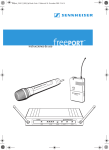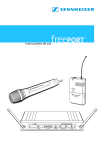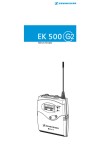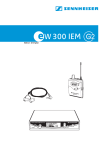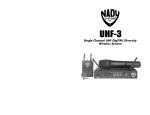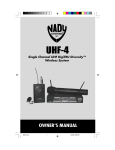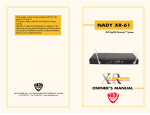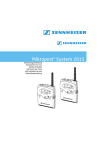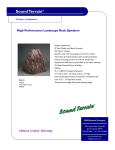Download Sennheiser Freeport User's Manual
Transcript
Bedienungsanleitung Instructions for use Notice d‘emploi Instrucciones de uso Bedienungsanleitung.......................................................................................................3 Instructions for use ....................................................................................................... 15 Notice d’emploi ............................................................................................................. 27 Instrucciones de uso..................................................................................................... 39 Instructions for use 15 Contents Safety instructions ...........................................................................16 The freePORT systems .....................................................................17 Delivery includes ........................................................................18 EM 1 receiver .....................................................................................18 SK 2 bodypack transmitter .............................................................20 SKM 3 radio microphone .................................................................22 Optimizing the system ....................................................................23 Care and maintenance .....................................................................24 If problems occur... ..................................................................... 25 Accessories and variants ................................................................25 Specifications of the freePORT systems ......................................26 Connector assignment ..............................................................26 Thank you for choosing Sennheiser! We have designed this product to give you reliable operation over many years. Over half a century of accumulated expertise in the design and manufacture of high-quality electro-acoustic equipment have made Sennheiser a world-leading company in this field. Please take a few moments to read these instructions carefully, as we want you to enjoy your new Sennheiser products quickly and to the fullest. Safety instructions Never open electronic units! If units are opened by customers in breach of this instruction, the warranty becomes null and void. Keep the units away from central heating radiators and electric heaters. Never expose them to direct sunlight. Use the units in dry rooms only. Use a damp cloth for cleaning the units. Do not use any cleansing agents or solvents. 16 The freePORT systems Designed for different areas of application, the freePORT systems are available in three variants. y Presentation Set: This system is ideal for presentation applications. The unobtrusive ME 2 clip-on microphone is virtually invisible. y Instrument Set: This system is for connecting musical instruments (e.g. guitar) which have a ¼” (6.3 mm) jack socket directly to the bodypack transmitter. y Vocal Set: This system is ideal for vocal and speech applications. Transmitters and receivers of the freePORT systems have four factorypreset frequencies for direct channel selection – ready for immediate use after switch-on. The freePORT systems are available in three UHF frequency ranges: y Frequency range A: y Frequency range C: y Frequency range E: 719 to 721 MHz 742.5 to 744.5 MHz 863 to 865 MHz Hinweise: The Frequency ranges A and C can only be used in certain areas in the EU and must be licensed with the regulating authorities. Frequency E is license-free in most EU countries (i.e. ETSI signatory countries). Please be legal and observe the country-specific regulations of the licensing authorities. Sennheiser are not responsible if you operate illegally. To avoid interfering with other users, the transmitter should be switched off when not in use. Features of the freePORT systems: y Up to four transmission links per frequency range which can be y y y y y operated simultaneously Reliable transmission technology Diversity technology for minimizing dropouts in the reception Adjustable squelch for eliminating RF interference Rugged housings Crystal-clear reception due to dynamic processor 17 ¼” (6.3 mm) jack cable ME 2 clip-on microphone Instructions for use X X X X Stand mount X X Mains unit X X X bodypack transmitter SKM 3 radio microphone Presentation Set (Model No. 21101) Instrument Set (Model No. 21104) Vocal Set (Model No. 21105) SK 2 FreePORT systems EM 1 receiver Delivery includes X X X X X X EM 1 receiver Operating controls Antenna A Operation indication, green LED (POWER) RF level indication, four green LEDs (RF LEVEL) Channel selector switch CHANNEL (1 to 4) Diversity indication, yellow LED A (lights up if antenna is active) Diversity indication, yellow LED B (lights up if antenna is active) AF PEAK, red LED (lights up if the audio level is too high) 18 Antenna B Audio output, XLR-3M socket, balanced (AUDIO OUTPUT XLR BAL) Audio output, ¼” (6.3 mm) jack socket, unbalanced (AUDIO OUTPUT UNBAL) Audio output level control (GAIN) Squelch threshold control (SQUELCH) DC socket for connection of mains unit (DC 11–18 V IN, 100 mA) Type plate Serial number Connecting the receiver 왘 Insert the DC connector on the mains cable into the DC socket and connect it to the mains. The green LED for operation indication (POWER) lights up and the receiver is ready for operation. 왘 To deactivate the receiver, remove the mains plug from the mains outlet. Aligning the antennas 왘 Set up the antennas and align them upwards in a V-shape. The LEDs A and B indicate which diversity section (i.e. which antenna) is active. Connecting the amplifier/mixing console 왘 Connect the amplifier/mixing console to the XLR-3M socket or the ¼” (6.3 mm) jack socket . 왘 Use the GAIN control to adapt the level of the audio output to the input of the amplifier or mixing console. The adjusted audio output level is common for both sockets. If the level is adjusted too high, the audio signal will be distorted. If, on the other hand, the level is adjusted too low, this will result in an audio signal with high background noise. Selecting and changing a channel You can change the channel on the receiver during running operation. The receiver then immediately receives on the new channel. 왘 Use a small screwdriver to set the channel selector switch to the desired channel. You can switch between four different channels (see “Selecting a channel” on page 24). 19 SK 2 bodypack transmitter Operating controls ON/OFF button Operation and battery status indication, red LED Microphone/instrument input, 3.5 mm jack socket (lockable) Antenna (can be screwed off) Battery compartment cover MIC/INST slide switch Serial number Channel selector switch CH (1 to 4) Sensitivity control GAIN Type plate Belt clip Inserting/replacing the battery We recommend powering the bodypack transmitter by a 9 V PP3 alkaline battery (IEC 6 LR 61). If powered by a rechargeable 9 V battery, the operating time will be drastically reduced. 왘 Open the battery compartment by first sliding the battery compartment cover in the direction of the arrow. Then flip the battery compartment cover open. 왘 Insert the battery as shown. Please observe correct polarity when inserting the battery. 왘 Close the battery compartment. Note: When the red LED goes off during operation, you must replace the battery as soon as possible. 20 Connecting the microphone/instrument cable The audio input is designed for the connection of both the ME 2 clip-on microphone and instruments (e.g. guitars). 왘 Connect the 3.5 mm jack plug from the microphone/instrument cable to the 3.5 mm jack socket . 왘 Check the setting of the MIC/INST slide switch which allows you to switch between microphone and instrument operation. If necessary, readjust the setting. 왘 Use the GAIN control to adjust the transmitter sensitivity so that the receiver receives a good audio signal (no distortion and no background noise). Attaching and positioning the microphone Use the microphone clip to attach the ME 2 clip-on microphone to clothing (e.g. tie, lapel). Conduct the microphone cable so that noise due to friction is avoided and make sure that the antenna and the cable do not cross. The omni-directional microphone picks up sound equally from all directions. However, it should be attached as close as possible to the sound source. Attaching the bodypack transmitter to clothing 왘 Use the supplied belt clip to attach the bodypack transmitter to clothing. Make sure that the antenna is at least 1 cm away from the body and is not kinked. Switching the bodypack transmitter on/off 왘 Press the ON/OFF button to switch the bodypack transmitter on or off. If the bodypack transmitter is switched on, the red LED lights up. Note: Remove the battery when the transmitter will not be used for extended periods of time. Selecting and changing a channel 왘 Switch off the transmitter before you change the channel. 왘 Use a small screwdriver to set the channel selector switch to the desired channel. You can switch between four different channels. When you switch on the bodypack transmitter again, it will transmit on the new channel (see “Selecting a channel” on page 24). 21 SKM 3 radio microphone Operating control Sound inlet basket Locking ring of battery compartment Body of radio microphone Battery compartment (not visible from outside) Antenna (can be screwed off) Operation and battery status indication, red LED (POWER) ON/OFF switch Channel selector switch CH (1 to 4) Type plate Serial number Note: The microphone head of the radio microphone cannot be changed. Inserting/replacing the battery We recommend powering the radio microphone by a 9 V PP3 alkaline battery (IEC 6 LR 61). If powered by a rechargeable 9 V battery, the operating time will be drastically reduced. 왘 Turn the locking ring of the battery compartment in the direction of the arrow. 왘 Pull the body of the radio microphone in the direction of the arrow as far as it will go. 왘 Insert the battery as shown. Please observe correct polarity when inserting the battery. 왘 Close and lock the radio microphone. Note: When the red LED goes off during operation, you must replace the battery as soon as possible. 22 Switching the radio microphone on/off 왘 Use the ON/OFF switch to switch the radio microphone on or off. If the radio microphone is switched on, the red LED lights up. Note: Remove the battery when the transmitter will not be used for extended periods of time. Selecting and changing a channel 왘 Switch off the radio microphone. 왘 Open the radio microphone (see “Inserting/replacing the battery” on page 22). 왘 Use a small screwdriver to set the channel selector switch to the desired channel. You can switch between four different channels (see “Selecting a channel” on page 24). 왘 Close and lock the radio microphone. 왘 Switch on the radio microphone again. Sensitivity of the radio microphone You can vary the bass reproduction by increasing/decreasing the talking distance. Setting up the system Before starting transmission, do a soundcheck and set up the system as follows: Setting up the reception The receiver’s four LEDs (RF LEVEL) indicate the level of the received RF signal. With the transmitter, walk up and down the transmission area and check if the received RF signal is sufficient everywhere. Reception is good if all four LEDs light up. Please observe the following: y Transmission range depends to a large extent on location and can be up to 100 m. Observe a minimum distance of 3 m between transmitter and receiver. There should be a “free line of sight” between transmitting and receiving antennas. y Do not operate the system close to metal objects such as cross members or reinforced-concrete walls. Computers or mobile phones in direct proximity to the antenna will interfere with the reception. y Each transmitter requires a receiver. When using several transmission links simultaneously, make sure that all transmission links operate on different channels. 23 Adjusting the squelch threshold Interference due to other transmission links can be eliminated as follows: 왘 Switch off the transmitter. The receiver should no longer receive a signal. 왘 If the receiver still receives a signal, use the SQUELCH control to increase the squelch threshold so that the signal will no longer be received. If the signal cannot be eliminated in this way, set the transmitter and the receiver to a different channel. 왘 Switch on the transmitter again and check if the receiver receives the transmitter signal. Note: If the squelch threshold is adjusted too high, the transmission range will be reduced. Therefore, always adjust the squelch treshold to the lowest possible setting. Selecting a channel Transmitters and receivers have four channels respectively with intermodulation-free frequencies. Note: These frequencies are different to those in evolution systems and freePORT systems should not be used together with evolution systems without great care. 왘 Always set the transmitter and the receiver to the same channel. Adjusting the transmitter sensitivity 왘 Use the GAIN control on the SK 2 bodypack transmitter to adjust the sensitivity so that even during the loudest passages the AF PEAK LED on the EM 1 receiver does not light up. Care and maintenance Use a slightly damp cloth to clean the units from time to time. Note: Do not use any cleansing agents or solvents. To clean the SKM 3’s sound inlet basket: 24 왘 Unscrew the sound inlet basket (turn counterclockwise) and remove it. 왘 Remove the foam insert and use a slightly damp cloth to clean the sound inlet basket. 왘 Reinsert the dry foam insert, replace the sound inlet basket on the SKM 3 and screw it tight. If problems occur... Problem No operation indication No RF signal Possible cause Possible solution Battery is flat Replace the battery No mains connection (receiver) Check the connections of the mains unit Transmitter and receiver are not on Set transmitter and receiver to the same channel the same channel Transmitter is out of range Reduce the distance between transmitter and receiver RF signal available, no audio signal Receiver’s squelch threshold is adjusted too high See “Adjusting the squelch threshold” on page 24 Audio signal has a high level of background noise or is distorted Transmitter sensitivity is adjusted too low or too high See “Connecting the microphone/ instrument cable” on page 21 The MIC/INST slide switch on the SK 2 transmitter is not set correctly Receiver’s audio output level is adjusted too low or too high See “Connecting the amplifier/ mixing console” on page 19 Accessories and variants 04839 MZW 1 Wind- and popshield for SKM 3 76670 MZQ 1 Microphone clamp for SKM 3 05018 ME 2 Clip-on microphone for SK 2, pre-polarized condenser microphone, omnidirectional 05019 ME 3 Headmic for SK 2, pre-polarized condenser microphone, super-cardioid 05020 ME 4 Clip-on microphone for SK 2, pre-polarized condenser microphone, cardioid 512889 CI1-fp Guitar cable Frequency range Presentation Set Instrument Set Vocal Set freePort fp 12-A-US freePort fp 72-A-US freePort fp 35-A-US with EU mains unit freePort fp 12-C-EU freePort fp 72-C-EU freePort fp 35-C-EU with US mains unit freePort fp 12-C-US freePort fp 72-C-US freePort fp 35-C-US with EU mains unit freePort fp 12-E-EU freePort fp 72-E-EU freePort fp 35-E-EU with UK mains unit freePort fp 12-E-UK freePort fp 72-E-UK freePort fp 35-E-UK 719–721 MHz: with US mains unit 742.5–744.5 MHz: 863–865 MHz: 25 Specifications of the freePORT systems System characteristics Transmission/receiving frequencies Switching bandwidth Signal-to-noise ratio THD (1 kHz) Temperature range 4 UHF transmission/receiving frequencies Range A: 719 to 721 MHz (719.15 – 719.75 – 720.15 – 720.85 MHz) Range C : 742.5 to 744.5 MHz (742.65 – 743.35 – 743.85 – 744.45 MHz) Range E: 863 to 865 MHz (863.1 – 863.7 – 864.1 – 864.9 MHz) 2 MHz > 95 dB(A) <1% –10 bis +45 °C / 95 relative humidity Individual components Power supply Operating time (with alkaline battery) Frequency response RF output power (-3 dB) AF output voltage ¼’’ (6.3 mm) jack socket (unbal.): XLR socket (balanced): Dimensions in mm Weight Transducer principle Pick-up pattern EM 1 receiver 12V DCNOM/100 mA – SK 2 bodypack transmitter 9 V PP3 battery approx. 10 hrs – – 60...16,000 Hz ± 3 dB 80...16,000 Hz ± 3 dB 10 mW 10 mW – – max. +10 dBu max. +16 dBu approx. 35 x 213 x 98 approx. 60 x 100 x 30 (with belt clip) approx. 570 g approx. 90 g – – – – SKM 3 radio microphone 9 V PP3 battery approx. 10 hrs approx. 285; ∅ approx . 35 x 50 approx. 210 g dynamic cardioid ME 2 clip-on microphone Transducer principle Pick-up pattern pre-polarized condenser omni-directional Type approval EU USA Canada see page 51 FCC - Part 74.861 grant of eqipment authorization DMOH1FPXD und DMOB1FPXD RSS - 123 with authorization IC: 2099A-FPSKMEM und IC: 2099A-FPSK Connector assignment EM 1: EM 1: EM 1: ¼’’ (6.3 mm) stereo ¼’’ (6.3 mm) mono XLR-3F connector, jack plug,unbalanced jack plug,unbalanced balanced + 2 1 EM 1: DC connector for power supply SK 2: 3.5 mm jack plug NC/GND 3 NC/GN D Instr./MIC 26 EG-Konformitätserklärung Diese Geräte ensprechen den grundlegenden Anforderungen und den weiteren Vorgaben der Richtlinien 1999/5/EU, 89/336/EU und 73/23/ EU. Die Erklärung steht im Internet unter www.sennheiser.com zur Verfügung. Vor Inbetriebnahme sind die jeweiligen länderspezifischen Vorschriften zu beachten! EC Declaration of Conformity This equipment is in compliance with the essential requirements and other relevant provisions of Directives 1999/5/EC, 89/336/EC or 73/ 23/EC. The declaration is available on the internet site at www.sennheiser.com. Before putting the device into operation, please observe the respective country-specific regulations! Déclaration de conformité pour la CEE Ces appareils sont conformes aux exigences essentielles et aux autres dispositions pertinentes de les Directives 1999/5/EC, 89/336/EC et 73/ 23/EC. Vous trouvez cette déclaration dans la internet sous www.sennheiser.com. Avant d'utiliser l'appareil, veuillez observer les dispositions légales en vigueur dans votre pays. Declaración de Conformidad Este equipo cumple tanto los requisitos esenciales como otras disposiciones de las Directivas 1999/5/CE, 89/336/CE y 73/23/CE. Si desea leer el declaración, visite la página www.sennheiser.com. !Anterior a la puesta en funcionamiento deberán observarse las correspondientes ordenanzas nacionales! 51 863 - 865 MHz Frequenzbereich, zugelassen in: Frequency range, approved in: Bande de fréquence, agrée en: Banda di frequenza, ammessa in: Gama de frecuencias, autorizado en: Frequentiebereik, toegelaten in: Taajuusalue, hyväksytty: Gama de frequências, autoriz. em: Πεδίο συχνοτήτων, µε άδεια για: A, B, CH, CY, CZ, D, DK, E, EST, F, FIN, FL, GB, GR, H, I, IRL, IS, L, LT, LV, M, N, NL, P, PL, S, SK, SLO 52 Garantiebestimmungen Wir übernehmen für das von Ihnen gekaufte Produkt eine Garantie von 24 Monaten. Ausgenommen hiervon sind dem Produkt beigefügte Zubehörartikel, Akkus und Batterien; denn diese Produkte haben wegen ihrer Beschaffenheit eine kürzere Lebensdauer, die zudem im Einzelfall konkret von Ihrer Nutzungsintensität abhängt. Die Garantiezeit beginnt ab Kaufdatum. Zum Nachweis heben Sie bitte unbedingt den Kaufbeleg auf. Ohne diese Nachweise, die der zuständige Sennheiser-Service-Partner prüft, werden Reparaturen grundsätzlich kostenpflichtig ausgeführt. Die Garantieleistungen bestehen nach unserer Wahl in der unentgeltlichen Beseitigung von Material- oder Herstellungsfehlern durch Reparatur, Tausch von Teilen oder des kompletten Geräts. Von der Garantie ausgenommen sind Mängel durch unsachgemäßen Gebrauch (z.B. Bedienungsfehler, mechanische Beschädigungen, falsche Betriebsspannung), Verschleiß, aufgrund höherer Gewalt und solche Mängel, die Ihnen beim Kauf bereits bekannt sind. Der Garantieanspruch erlischt bei Eingriffen in das Produkt durch nicht autorisierte Personen oder Werkstätten. Im Garantiefall senden Sie das Gerät inklusive Zubehör und Kaufbeleg an den für Sie zuständigen Service-Partner. Zur Vermeidung von Transportschäden sollte möglichst die Original-Verpackung verwendet werden. Ihre gesetzlichen Mängelansprüche aus dem Kaufvertrag gegen den Verkäufer werden durch diese Garantie nicht eingeschränkt. Die Garantie kann weltweit in allen Ländern – außer in den USA – in Anspruch genommen werden, in denen das jeweils nationale Recht unseren Garantiebestimmungen nicht entgegensteht Warranty regulations The guarantee period for this Sennheiser product is 24 months from the date of purchase. Excluded are accessory items, rechargeable or disposable batteries that are delivered with the product; due to their characteristics these products have a shorter service life that is principally dependent on the individual frequency of use. The guarantee period starts from the date of original purchase. For this reason, we recommend that the sales receipt be retained as proof of purchase. Without this proof (which is checked by the responsible Sennheiser service partner) you will not be reimbursed for any repairs that are carried out. Depending on our choice, guarantee service comprises, free of charge, the removal of material and manufacturing defects through repair or replacement of either individual parts or the entire device. Inappropriate usage (e.g. operating faults, mechanical damages, incorrect operating voltage), wear and tear, force majeure and defects which were known at the time of purchase are excluded from guarantee 53 claims. The guarantee is void if the product is manipulated by nonauthorised persons or repair stations. In the case of a claim under the terms of this guarantee, send the device, including acces-sories and sales receipt, to the responsible service partner. To minimise the risk of transport damage, we recommend that the original packaging is used. Your legal rights against the seller, resulting from the contract of sale, are not affected by this guarantee. The guarantee can be claimed in all countries outside the U.S. provided that no national law limits our terms of guarantee. Conditions de garantie La période de garantie pour ce produit Sennheiser est de 24 mois à compter de la date d'achat. Sont exclues, les batteries rechargeables ou jetables livrées avec le produit. En raison de leurs caractéristiques ces produits ont une durée de vie plus courte liée princi-palement a la fréquence d'utilisation. La période de garantie commence à la date de I'achat. Pour cette raison, nous vous recom-mandons de conserver votre facture comme preuve d'achat. Sans cette preuve -qui est vérifiée par Sennheiser -aucune prise en compte de la garantie ne pourra être retenue. La garantie comprend, gratuitement, la remise en état de fonctionnement du matériel par la réparation ou le remplacement des pièces défectueuses ou dans le cas où la réparation n'est pas possible, par échange du matériel. L'utilisation inadéquate (mauvaise utilisation, dégâts mécaniques, tension électrique incorrecte), sont exclus de la garantie. La garantie est invalidée en cas d'intervention par des personnes non-autorisées ou des stations de réparation non agrées. Pour faire jouer la garantie, retournez I'appareil et ses accessoires, accompagne de la fac-ture d'achat, a votre distributeur agrée. Pour éviter des dégâts durant le transport il est recommandé d'utiliser I'emballage d'origine. Votre droit légal de recours contre le vendeur n'est pas limité par cette garantie. La garan-tie peut être revendiquée dans tous les pays à l'extérieur des Etats-Unis à condition qu'aucune loi nationale n'en invalide les termes. 54 Declaración de garantia EI periodo de garantia para este producto es de 24 meses desde la fecha de compra. Quedan excluidos los accesorios adjuntos al producto, acumuladores y baterias dado que, debido a sus caracteristicas, la vida útil de dichos productos es mucho más corta y, en determinados casos, depende concretamente de la intensidad de utililación. EI periodo de garantia comienza a partir de la fecha de compra. Por eso le recomendamos que guarde el recibo como prueba de compra. Sin dicha prueba, que será verificada par el respectivo concesionario Sennheiser, cualquier reparación que sea necesaria será efectuada contra factura. Según determine el fabricante, las prestationes de garantia consistirán en la eliminación gratuita de defectos de materiales o fabricatión, por medio de reparación, sustitución de piezas, o bien en la sustitución del aparato completo. La garantia no tendrá validez en caso de defectos ocasionados par un uso inadecuado (tales como manejo incorrecto daños mecánicos, tensión de servicio equivocada), desgaste, o bien efectos de fuerza mayor, y desperfectos ya detectados en el momento de adquirir el producto. La garantia carecerá de validez si el defecto se debe a modificationes y reparaciones hechas en el pro- ducto por personas o talleres no autorizados. En caso de reclamación sirvase remitir el aparato incluyendo los accesorios y la factura al con-cesionario Sennheiser encargado de su zona. A fin de evitar daños durante el transporte se aconseja emplear el envase original. Las pretensiones legales por defectos y emanadas del contrato de compraventa frente al vendedor, no quedan limitadas por esta garantia. La garantia esta disponible en todos los paises a excepción de EE.UU., siempre que la legislación nacional aplicable no sea contraria a nuestras determinaciones de garantia. 55 Sennheiser electronic GmbH & Co. KG 30900 Wedemark, Germany Phone +49 (5130) 600 0 Fax +49 (5130) 600 300 www.sennheiser.com Printed in Taiwan Publ. 11/05 514013 / A03





















